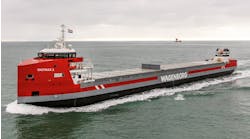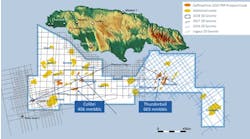Will new administration alter development scenario?
Events in Russia this month should stir the stasis over the country's Far East offshore developments. On the 22nd, the Sakhalin II partners must decide whether to proceed with the project or break their production sharing agreement.
The outcome of the presidential elections could also impact the future course of this and other agreements in the Sakhalin region. Western oil companies were generally unhappy with the watered down version of the production sharing law approved by Russia's parliament last December.
Proposed rights for investors have been restricted, with Russia retaining the right to scrap development deals according to oil price movements. Some Sakhalin officials are sympathetic to oil company demands for the amendments to be counteracted, but a new national administration could even take a more draconian line. Then the Sea of Okhotsk shelf might be shelved indefinitely.
The pre-election authorities were anxious for this not to happen, particularly Ivan Tchernov, director of offshore developments at Rosneft who was also responsible for the Caspian Sea area being opened. Speaking at a recent conference in London on Russian/CIS oil industry investment, organized by the UK's Royal Institute of International Affairs, Tchernov played up the importance of the Sakhalin region:
"Sakhalin I and II are the first large fields based on production sharing in Russia. It's no accident that the PSA on II is the first agreement signed by the government with foreign investors, and it became the basis of the PSA law approved last December.
"Development should improve living standards in that region. But these projects are not only of economic, but political significance, so it's very important that success should result."
On Sakhalin I, where Rosneft is a partner with Exxon, Sodeco and Sakhalinmorneftegaz, some progress was achieved last year, he said, in addition to signing of the PSA. "The organizational structure for the project was under way, offices were opened and contacts established with the local authorities."
In other respects, however, development ground to a halt and for that, he said, "we all take the blame". But the aim now was to progress the project as quickly as possible. "We have to propose to the partners beginning work concerning exploration of the Arkutun-Dagi Fields, whether or not the program calls for it" - and whether or not this is popular with the partners.
Tchernov declined to criticize outright the Sakhalin II consortium (Shell, Marathon, McDermott, Mitsubishi and Mitsui), but pointed out that no work had been done on that project since the handshakes two years ago apart from adoption of the PSA.
Assuming the partners affirm their commitment this month, progress needs to be made towards a commencement date, said Frank Duffield of Shell. Appraisal of the optimal field development was required based on further, more accurate drilling and a preliminary project execution (with financing in place).
"It's essential to keep down development costs. If the economic review proves favorable, we will proceed with a more definitive, technical review."
Sakhalin II comprises two discoveries, Piltun-Astokhskoye and Lunskoye. The former is situated 16 km offshore Sakhalin Island in 30 meters of water, between the two Sakhalin I fields. According to Duffield, the complexity of the reservoir constrains full development: nevertheless, 750 MM bbl of oil and condensate are thought recoverable, with oil throughput of 120,000 b/d. Associated gas could be produced at 160-250 mcf/d, increasing when oil output eases back.
This would probably entail installation of two platforms, whereas Lunskoye, 150 miles to the south in 15 meters water depth, could be accessed through a single monopod platform, Duffield said. Currently gas reserves there are put at 11 tcf with 325 MM bbl of associated oil and condensates.
Oil and gas would likely flow to a common processing facility, with the potential for a 25-year LNG contract and piping of gas to the mainland for domestic needs. All this would involve building an LNG plant and an oil terminal in the south of the island.
Given current progress, LNG agreements are unlikely before 1998, said Duffield, and then LNG shipments couldn't be expected before 2004. First gas could be delivered from Piltun-Astokhoskoye in 2000, however. He was optimistic that preliminary work could be accomplished over the next few months.
Sakhalin Region governor Igor Farkhoutdinov said that almost 4 billion tons of oil and 2 tcm of gas was available around the shelf. Sakhalin III involving Exxon, Mobil and Texaco was under way, and over the next year, he expected lift-off for Sakhalin IV, V and VI in the Bay of Sakhalin. "Here we hope for Russian investment too."
Sakhalin I update
Sakhalin I comprises three offshore fields on the north-east Sakhalin shelf: Odoptu, Chayvo, and the more recent Arkutun-Dagi discovery. Speaking at the investment conference in London, Exxon Neftegaz president Robert Olsen estimated capital spending for the project at over $15 billion, including six ice-resistant platforms, a north-south oil and gas pipeline and processing facilities and an LNG plant at Val and Prigorodnoye.
However, these plans may change, he said, as conceptual engineering advances. The main design and operating challenges include multi-zone reservoirs with varying hydrocarbon qualities; five to six months of ice-covered waters; and active seismic zones.
"The Sakhalin I fields include multiple, stacked reservoirs with net pay thickness ranging widely. Reservoir rock and fluid properties also vary greatly. Some of the productive zones have gas caps, others do not. Effective reservoir management to maximize recoverable reserves will require careful planning."
Preliminary design ice loads have been developed, he said, based on model tests and field measurement programs conducted by Exxon and others and data on ice compiled by Russian institutes. But more ice data is needed to improve the design load criteria.
Earthquake magnitude in the Sakhalin area is on a par with strikes off Japan and California. Olsen claimed that Exxon's seismic design technologies for platforms in these regions had withstood structural damage during numerous earthquakes, and so would be applicable to Sakhalin.
Near term, the Sakhalin I partners plan to assimilate past studies by Russian institutes into design parameters for the project. A phased development will also be examined, including an evaluation of the benefit of horizontal wells and the options for lower cost oil and gas export. And infrastructure sharing with other Sakhalin operators will be explored.
To better define estimates of recoverable reserves at the three fields, the partners plan a program that includes drilling, coring and testing of up to ten further wells, and 3D seismic surveys costing up to $300 million (the first such surveys in the Russian Far East). The aim is to determine hydrocarbon distribution, reservoir quality, hydrocarbon saturation and net sand thickness.
Other state of the art technologies likely to feature, he said, would include upward-looking sonar and multibeam sonar, used to collect ice ridge, ice gouge, and sea floor lithodynamic data.
Olsen forecast direct capital and operating expenditure on labor, materials and services during the life of the project at $40 billion, much of this allocated to the Russian private sector. Between 20-40,000 jobs could be created.
When the legal and fiscal framework is in place to ensure that the PSA provisions are valid and enforceable as negotiated, the project can proceed, he said. The partners are then committed to providing $100 million to the Sakhalin Island Development Fund to aid social and economic infrastructure, including health care, communications, and transportation.
Copyright 1996 Offshore. All Rights Reserved.


